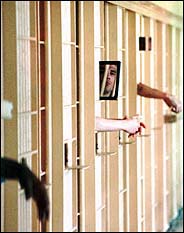

 |
| Associated Press |
| On death row at Florida State Prison in 1989, an inmate peeked from his cell. |
 |
| Associated Press |
| Gov. George Ryan of Illinois, right, announcing the findings of his capital punishment commission at a press conference in Chicago on April 15. |
TWO years ago, the lawyer and novelist Scott Turow was recruited to serve on a state commission in Illinois that was studying capital punishment for Gov. George Ryan.
The appointment hit Mr. Turow right between his certainties. Yes, his state had made some harrowing errors since reinstating the death penalty in 1977. And Mr. Turow himself had helped free an innocent man mistakenly convicted of murder. On the other hand, in 1994 Illinois had also executed John Wayne Gacy, one of the most notorious fiends in the annals of 20th-century crime. Mr. Gacy tortured and killed 33 men and boys, then buried many of them in the crawl spaces of his house.
Mr. Turow, a former federal prosecutor in Illinois, said of the death penalty: "I wasn't somebody who thought this was immoral, this is always unjust. I do respect the right of a political majority to decide this, and I cannot look at a system that executes the likes of John Wayne Gacy as immoral."
It was not, of course, the death of the unlamented Mr. Gacy that prompted Governor Ryan to declare a moratorium on executions in January 2000 and order a study of the issue. The jolt came from the 13 innocent people who were discovered on death row, as opposed to the 12, Mr. Gacy included, who had been executed.
One of the 13 to be set free, Anthony Porter, almost did not make it home. Convicted of murder, he came within 50 hours of being lethally injected before young journalism students at Northwestern University dug up evidence that cleared him and led to the arrest of another man.
When more exonerations followed soon after, Governor Ryan, a Republican and a death penalty supporter, said, "Enough." Then, he charged a panel of prominent citizens with finding out what went wrong in those 13 cases, and to see if capital punishment could be "just, fair and accurate."
The questions raised in Illinois range far beyond one state and the chill air of capital litigation. If death penalty cases, which receive so much scrutiny, are flawed, what about all the other the day-to-day dispositions meted out in assembly-line style by an overburdened criminal justice system?
Later this year, the American Judicature Society, a research and educational organization with a number of judges as members, will consider a proposal for "innocence commissions," which would try to find out how and why the system fails, much as the National Transportation Safety Board reviews airplane crashes.
SINCE 1989, 106 people have walked out of prison, and in 12 cases off death row, because of DNA tests, which either conclusively established their innocence or vitiated the original prosecution case. And while this group represents just a tiny fraction of the criminal convictions in the United States, the mounting weight of their stories has convinced judges, lawyers and police investigators to look at how the wrong people end up behind bars.
More than 30 years ago, William H. Webster advised the Nixon-Agnew campaign on crime issues, setting the tone for the first modern national campaign on law and order. After a long career as a prosecutor, federal judge and the director of both the F.B.I. and C.I.A., Mr. Webster served as a special advisor to the Illinois commission.
"I had a firm view that very few innocent people were convicted, and that far more guilty people got off than innocent were convicted," Mr. Webster said recently. His mind was changed, he said, by the developments of just the last two years, when the pace of DNA exonerations nearly tripled.
"There are proportionally far more innocent people convicted than I ever thought there were," Mr. Webster said.
Because DNA exonerations have the power to refute the most persuasive, sincere and positive eyewitnesses, they have forced a reconsideration of the "physiology of truth," said Janet Reno, who served as United States Attorney General from 1993 to 2000.
Interviewed by phone from Florida, where she is running for governor, Ms. Reno reeled off questions posed by the exonerations: "How does the mind treat memory? When it dredges something up from memory does it imprint it with new codes? How we do best ensure correct memory, from a psychological and physiological point of view?"
One approach worth exploring, the Illinois commissioners decided, was a new technique for questioning eyewitnesses adopted last year by the state of New Jersey. That state's attorney general ordered police departments to drop the classic lineup or photo array, in which witnesses were asked to choose among six suspects. Instead, the witnesses will be shown one picture at a time, a procedure that researchers say will not reduce the number of correct identifications but will cut down on bad guesses.
THE Illinois commission also suggested videotaping all statements, to minimize coercion, since about one in five wrongful convictions appear to rest on false confessions.
These are the sorts of "best practice" remedies that many researchers have suggested for investigating all crimes, and certainly in capital cases, where lives are at stake.
Last July, Justice Sandra Day O'Connor, who has provided pivotal votes upholding death sentences during her two decades on the United States Supreme Court, said she was troubled by the number of innocent people found on death row. Nearly all had lost their appeals to higher courts, meaning that the judiciary had found that the system worked just fine.
"The availability of DNA testing for death-row inmates may partially alleviate this concern," Justice O'Connor said in a speech to the Minnesota Women Lawyers that was transcribed by The Associated Press. She noted that a number of states with capital punishment did not offer the tests, and added: "Evidence is only available for testing in a relatively small number of cases."
Justice O'Connor also said she was disturbed by the uneven quality of defense lawyers appointed to represent the poor at capital trials.
The Illinois commission did not dwell on the execution of terrible criminals of the John Wayne Gacy ilk, though it did report on the near-catastrophes of executing innocence people like Mr. Porter. Basically, it sought fairness. Between two poles, one marked Gacy, the other marked Porter, is the run of the American death row: criminals who have killed, and unlike most murderers, wind up being sentenced to die. For every John Wayne Gacy, scores of other murderers almost arbitrarily face death, rather than prison time, for their crimes.
Across this landscape of human and spiritual ruin, the commission looked at a number of by-now familiar questions, like how the race and gender of a victim tilts penalty decisions; the ways in which a county border also becomes the boundary between a life sentence or death; the relevance of age, mental or actual, to moral culpability; the difficulty of insuring competent defense counsel; and what bearing brutally abusive childhoods should have on the fate of brutal criminals.
Given the complexity of these problems, the commission said its prescriptions were bound to be expensive and cumbersome, but they were not intended as a poison pill for capital punishment. Michael Waller, the state's attorney for Lake County, Ill., and a member of the commission who supports capital punishment, said that the reform efforts of the panelists were in earnest. But he worried that death penalty abolitionists would use their work to choke off the punishment.
"Their goal is to have the death penalty repealed, not to make it workable," Mr. Waller said.
AS the commission released its 207-page report calling for overhaul of the state's capital punishment system last week, Mr. Turow counted himself in the narrow majority calling for the abolition of the death penalty — not because it is morally wrong, but because it is practically impossible.
"As I dealt with this issue for the last two years on a systemic basis, I just couldn't find any way to rationalize who gets executed and who doesn't," he said last week. "My own conclusion is I just don't see how this can be fairly administered."